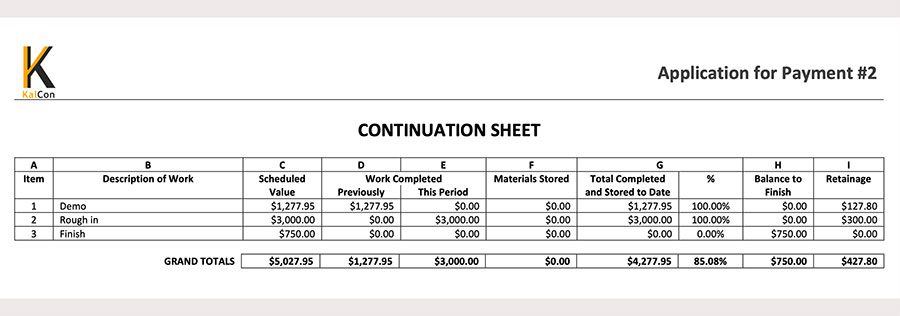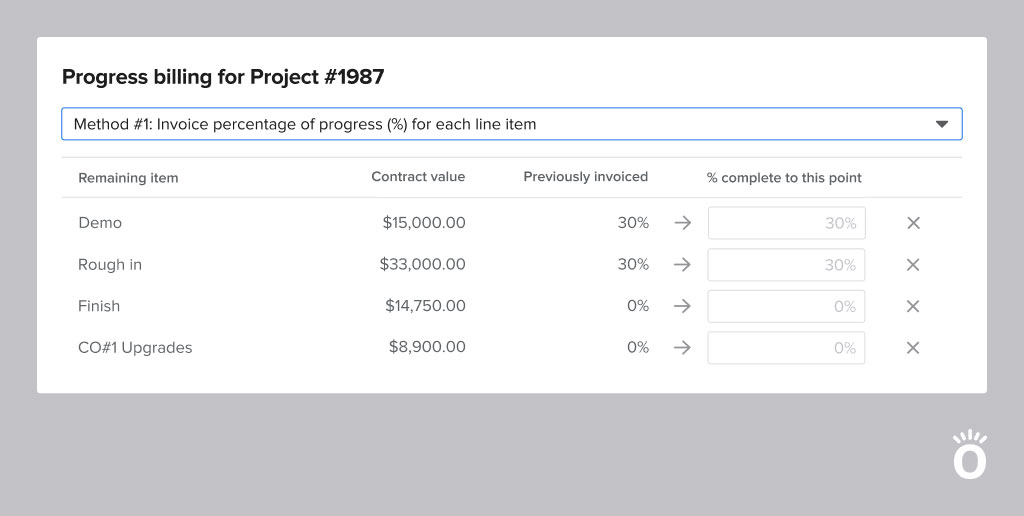

Although progress billing is commonplace in the construction industry, many aspects of how it functions can be difficult to understand. However, through better contract comprehension, contractors can make better decisions and get paid faster. This article will aims to give contractors everything they need to know about progress billing in construction.
Progress billing is a method of invoicing common in long-term projects with multiple phases. The process facilitates payments for labor, materials and other project expenses to the contractor as work is completed, and before total project closeout.
In a practical sense, progress billing allows contractors to bill clients for partial payments of the total project at specific job stages. For this to work, the contractor will agree to a payment schedule that identifies the specific stages and a completion date. Then, as work is completed, the contractor will prepare and send a bill to the client. In comparison, a smaller fixed-price contract might feature just one job phase, with the entire project paid for in-full up-front.
On the other hand, progress billing will have multiple invoices at different prices based on the percentage of completion. For example, let’s look at a contract for $70,000, to be billed on a percent completion basis at the end of each month. At the end of the first month, with 10% of the project completed, a progress invoice reflecting 10% of the total ($7,000) will be sent to the client.
This invoice will detail the completed work and is formatted to fit the documentation requirements of the specific project. For example, a GC might require the subcontractor to submit an AIA payment application using AIA forms G-702 and G-703.
For project owners, this billing method will avoid the need to provide large sums of money upfront to fund construction projects. For this reason, it’s favored by long-term projects with large scopes of work or by contracts with high dollar amounts. Additionally, progress billing allows for projects to be reviewed periodically. Mutually beneficial for both builders and project owners, progress billing offers the opportunity to repeatedly evaluate ongoing jobs.
As a stage is completed, work and project costs are reviewed by all stakeholders: What was done? Was it done correctly? Was it done on time? How much did it cost? Is this project on track to be completed on time and within budget? Answering these questions helps all construction companies make better decisions to make sure the final outcome meets expectations.
A comprehensive schedule of values (SoV) will list every work item with an associated cost for the entire project. This should include a detailed breakdown of cost, level of completion, and the percentage already paid for each task. An SoV guarantees that every piece of work has a chunk of the total contract amount attached to it. Structuring it this way also provides a step-by-step list of the entire project with associated costs; allowing both builders and project owners to quickly check the progress of a job.
These periodic checks come in handy when it comes to cash flow management. Contractors can evaluate job costs, make adjustments, and assess how to manage their finances for the remaining project phases. Additionally, getting paid in intervals allows for more strategic decision-making when purchasing materials or equipment for upcoming phases.
Contractors who match their budgets with major project milestones can assess cash needs for each project phase. Identifying gaps in cash flow before a project phase starts enables general contractors and specialty contractors to work together better to find a profitable path forward.
A schedule of values will typically comprise of a table with rows providing an itemized list of work. Each itemized portion of work should include a description that details the work being done and the cost–or allocated contract sum–this task will incur; this is known as the scheduled value, which gives the overall document its name. Additional information may be needed in many AIA-style documents, such as the G702 or G703. This will include amounts of completed work covered by previous payment applications, the value of stored materials, completion percentage, and retainage. In the end, a well-structured SoV presents a clear record of work completed and the amounts to be paid.
Retainage is the long-standing practice of withholding a small amount of money from each payment. The amount is typically a set percentage taken out of every payment and set aside until the end of the project. Then, if the project is completed up to the contract’s requirements, all money withheld is distributed back to the contractor. Project owners use retainage as an insurance policy should the job fall short of expectations.
Retainage is often used interchangeably with retention. However, there’s a slight difference to note here. Retainage is the amount of money held back until a project is completed, whereas retention is the actual act of withholding the money. In most circumstances, retainage is a fixed percentage of the subcontractor’s bill withheld as collateral.
A typical retainage percentage is around 10%, but this number can vary greatly depending on local and state laws. For this reason, contractors must understand the retainage details of the contract they are working under. It can be challenging to initiate the release of your retainage–which is rightfully your money–after a job ends; it’s often better to negotiate a partial release of retainage at 85% or 90% completion.
There will be a section to record retainage percentage information when using AIA-style documents. Per the contract, contractors should note the amount of retainage and ensure this amount is calculated correctly for every invoice. Contractors must closely monitor their “total earned less retainage” (total amount of money earned for completed work minus the retainage percentage).
This number will give you an accurate look at the actual amount of money you are bringing in; a vital piece of information for cash flow management. There could be situations in which a contract utilizes a variable retainage. This would mean the amounts withheld are gradually reduced as the job progresses. Additionally, there could be different retainage percentages for specific phases, materials, or requirements.
As contractors hit milestones, they must send a payment application that initiates the payment process. Before this can be done, the contractor must prepare a detailed schedule of values.
Contractors must break down the entire project, task by task, and then assign a portion of the contract amount to each task. In addition, each work item should have a brief yet detailed description. From here, it is crucial to have columns created to record and track progress and dollar amounts. These sections should include the following:

While creating the schedule of values, contractors will need to negotiate payment schedules with the project owner. These payment schedules will denote project milestones, with each milestone serving as a billing period.
Billing periods can be based on many factors depending on the requirements of the project or the needs of the contractor. However, clear and agreed-upon payment schedules are crucial to ensure smooth progress billing processes, protect both parties’ interests, and facilitate accurate financial planning during project planning and execution.
The schedule of values is the basis for reviewing payment applications. For this reason, information needs to be consistent between the schedule of values and the payment schedule. In addition, both will be frequently referenced by the project owner, so accuracy is essential here.
We can’t say it enough, it’s critical that you and the project owner establish clear project milestones for triggering payments that comply with the payment terms outline in the contract.

While this step is not fundamental to the progress payment process, it does serve as a crucial step for contractors wishing to improve cash flow management. Once a schedule of values is created with a detailed payment schedule, contractors will have a solid framework for understanding cash needs for every stage of the job. We recommend that contractors use this to create a detailed budget. This budget can then be matched up against the project timeline and payment schedule. This exercise will determine where you can expect cash surpluses or shortfalls. Use this information to create better schedules, project plans, job costing procedures, and more.
If you know you will have cash issues at specific times, discuss this with the project owner to find a way forward that works for everyone. The goal here isn’t to be self-serving. Cash flow issues can leave contractors strapped for cash, leaving the door open for potential project delays or sub-par outcomes. Addressing cash flow issues before they impact the job is crucial to keep projects moving.
Contracts will include many details outside payment terms, such as the scope of work, federal regulations, change order management, and payment dispute processes. Take the time to ensure contract terms align with the schedule of values and payment schedule. As mentioned, if terms need to be adjusted to better align with your cash flow needs, now is the time to have those discussions. As it relates to payment terms, double-check retainage laws for your state. Ensure the contract properly reflects those requirements.
After the contract is finalized and signed, work can begin until the first agreed-upon milestone is reached. Once the first payment period is reached, contractors must compile all information needed to prepare an invoice.
If following an AIA-style process, contractors will need to fill out a payment application. Pay apps are documents that consolidate all information needed to bill and receive the right amount. Drawing heavily from the schedule of values, the payment application will detail each completed work item, the amount owed for each item, and retainage information. From this payment onward, contractors will need to include percentage of work completed, the balance paid to date, the current outstanding amount owed, and the balance remaining to be invoiced for the entire project.
Payment applications are the catalyst for receiving payments, so contractors must pay special attention to the accuracy of these documents before they send them off. All numbers should be meticulously calculated and double-checked for accuracy. A single inaccurate payment application will cause all subsequent payment apps to be inaccurate. Therefore, it’s best to take your time and triple-check if you have to.
Additionally, understanding the remaining balance is crucial as it ensures both partices are aware of the total amount still due after accounting for payments made and ongoing project costs, clarifying financial obligations as the project progresses.
After a comprehensive internal review, the contractor will need to send the invoice to the project owner for final review. Again, all information will be reviewed and verified. This is where it pays to take the extra time to ensure all information is correct. The less time it takes the project owner to review and amend issues, the faster contractors can get paid.
Project owners will distribute payments according to the contract terms if all information is correct and properly documented. From here, the project’s next phase will be underway, and at the end of this milestone, the entire process will begin anew.
All changes hinge on proper documentation, whether due to change orders or unforeseen project circumstances. Failure to document changes will result in severe financial consequences down the road. Always ensure that change orders are backed by accurate numbers (whether or not you were the one to request the change). This means proper descriptions, calculations, and approvals for any change must be provided.
The process should include identifying the change via a discussion will the project manager or any stakeholders. From there, supporting documentation must be created detailing why the change is needed and what the exact change is. Finally, a formal review and approval process should take place. Whatever the case, double down on documentation. Ensure there is a clear understanding of what the change is, why it’s needed, and how it impacts the overall scope of work and cost of the project.
Progress billing is well-established in the construction industry culminating in AIA-style industry standards. All specialty trades contractors can use these standards to standardize the progress billing process. While the AIA provides specific branded documents for contractors to use, most project owners will accept non-branded forms as long as they follow the same layout and structure as the official AIA documents.
For project owners, progress billing will avoid the need to provide large sums of money upfront to fund projects. For contractors, this method allows for a steady stream of cash flow used to cover material costs and labor costs with more precision.
By design, progress billing allows for improved project evaluation. As a stage is completed, work and costs are evaluated: What was done? Was it done correctly? Was it done on time? How much did it cost? Is this project on track to be completed on time and within budget? Answering these questions at regular intervals helps to ensure the final outcome is up to expectations.
Additionally, project completion serves as a crucial milestone for invoicing. Final payments are released when the customer is satisfied that the project meets the contractual requirements. Because of this, it’s imperative that contractors track and document project progress so they can prove key milestones have been met satisfactorily.
Progress payments break a job down into more manageable stages, as opposed to one large complex job. Each stage can be approached separately under progress billing. If the terms or deadlines for a specific phase of the project need adjusting, those changes can be made without affecting the entire project. For this reason, progress billing is favored by long-term projects with large scopes or construction contracts with high dollar amounts.

As we have seen, there are a lot of moving parts when it comes to progress billing in construction. For this reason, preparing progress invoices can be time-consuming and frustrating. These frustrations are made even worse when keeping track of it all in outdated spreadsheets.
Using Knowify allows contractors to evaluate costs, create professional invoices, bill clients, and track payments all in one system. We turn a complex, multi-step process into a quick and easy part of your day. Contractors can send professional invoices in minutes with templates that will adjust to invoice outputs. Just click Invoice now, and Knowify will give you all the information you need to invoice for the progress up to date in addition to everything you’ll need to produce upcoming invoices.
Master progress billing, accurately track percentage of completion, and ensure precise billing with Knowify’s construction invoicing and payments software. Schedule a 1-on-1 demo today.